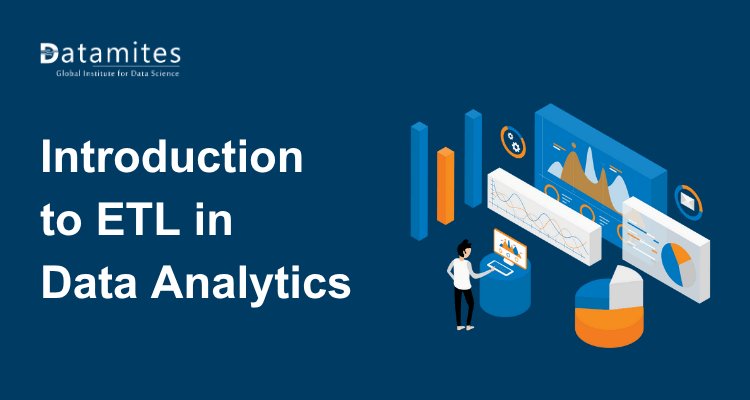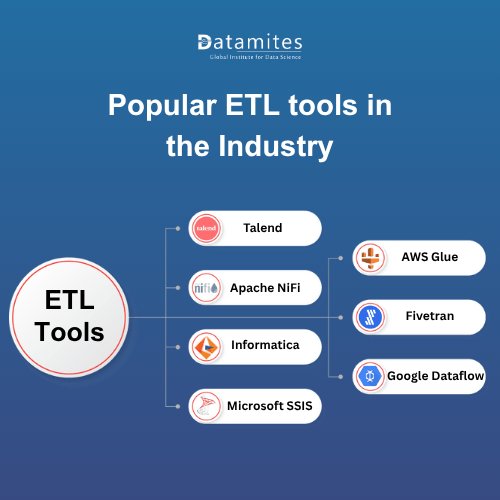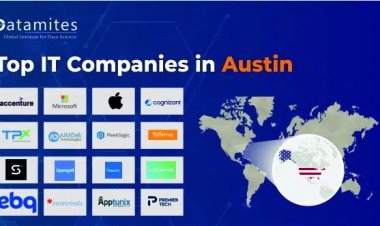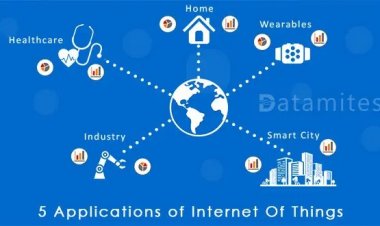Introduction to ETL in Data Analytics
Discover the fundamentals of the ETL in data analytics, its role in data warehousing, real-world applications, key tools, and future trends. Learn how ETL supports data analyst careers by enabling clean, integrated, and actionable data insights.

In the world of modern business intelligence, data is the new oil, but only if it’s processed and refined correctly. The ETL process in data analytics plays a vital role in preparing raw data for meaningful insights. From extracting data from scattered sources to transforming and loading it into centralized systems, ETL forms the foundation of efficient data integration and decision-making.
This article explores the ETL process in data warehousing, the significance of ETL tools, and its applications across industries. Let’s delve into how ETL powers today’s data-driven enterprises and what its future holds.
What is ETL?
ETL stands for Extract, Transform, Load, a structured process used to move data from various data sources to a centralized data warehouse. It is a core component in building data pipelines that enable reliable business intelligence and reporting.
- Extract involves gathering raw data from sources like databases, APIs, cloud storage, spreadsheets, or even IoT devices.
- Transform focuses on data transformation: cleaning, enriching, normalizing, and validating data to ensure consistency and quality.
- Load is the process of inserting the cleaned data into a target system such as a data warehouse or analytics platform.
Together, the ETL process in data warehousing ensures that business users access standardized, high-quality data for reporting, analysis, and strategic decisions. ETL data pipelines form the backbone of data analytics and machine learning workflows. By applying business rules, ETL cleans and structures data to support tasks like monthly reporting and business intelligence.
Refer to the articles below:
- Applying Data Analytics to Finance
- Top statistical tools for data analysis
- Data Science Vs Data Analytics
Why is ETL important and its future trends
ETL plays a vital role beyond just transferring data, it ensures data quality, consistency, and integration across various platforms and formats and it can be mastered by learning the top IT courses in demand. By delivering clean, structured data, ETL enables advanced business intelligence and visualization.
Its scalability supports growing big data needs, making it essential for effective analytics and informed decision-making. The Research Gate Report highlights that over 70% of big data projects rely on ETL tools for effective data integration and preparation.
Some of the future trends in ETL:
Emerging technologies and changing business demands are pushing ETL beyond conventional batch processing into cloud-native, real-time, and intelligent data integration ecosystems. The future trends and the emerging technology that demand ETL are mentioned below:
1. Cloud-based ETL adoption
According to a report by Gartner (2024), more than 75% of enterprises will use cloud-native ETL platforms by 2026. Tools like AWS Glue, Azure Data Factory, and Google Cloud Dataflow are leading this shift. These tools offer scalability, flexibility, and seamless integration with cloud data warehouses like Snowflake and BigQuery, enabling businesses to manage large data volumes without managing infrastructure.
2. Real-Time and streaming ETL
The demand for real-time analytics is fueling the adoption of streaming ETL solutions. MarketsandMarkets projects the real-time analytics market to grow from USD 0.8 billion in 2023 to USD 6.7 billion by 2028, at a CAGR of 20.2%. Tools like Apache Kafka, Apache Flink, and StreamSets are enabling continuous data ingestion and transformation, empowering dynamic dashboards and instant alert systems.
3. AI-enhanced ETL processes
Artificial Intelligence (AI) is transforming ETL by automating complex data processing tasks. AI-driven ETL platforms now integrate machine learning models to detect anomalies, recommend data transformation logic, and auto-correct data quality issues. A Forrester report (2024) emphasizes that AI in ETL can reduce data pipeline development time by up to 40%, enhancing both accuracy and speed.
4. Low-Code/No-Code ETL tools
The rise of low-code/no-code platforms is democratizing ETL development. These platforms, such as Talend, Matillion, and Hevo Data, offer drag-and-drop interfaces that allow business analysts and non-developers to create and manage data pipelines. IDC (2023) notes that by 2026, 65% of ETL workflows will be developed using low-code/no-code tools, reducing IT bottlenecks and fostering data ownership across departments.
As businesses prioritize speed and agility, the ETL process in data analytics is becoming more automated, intelligent, and scalable.
ETL process in data warehousing
The ETL process in data warehouse environments is essential to maintaining structured, analytical-ready datasets. In a typical data warehouse architecture, ETL bridges operational systems and analytical platforms. Here is the process involved in data warehousing:
1. Source systems identification
Data is gathered from various sources such as operational databases, CRM systems, ERPs, and third-party platforms. These sources often have different formats and structures, leading to fragmented information. The ETL process begins by identifying and connecting to these systems for data extraction.
2. Extraction
Raw data is extracted using connectors or scripts, either in full, incrementally, or in real time. This step captures the most recent or relevant changes from the source systems. Efficient extraction is critical for maintaining data freshness and accuracy.
3. ETL layer
Data undergoes cleansing, deduplication, formatting, and enrichment using ETL tools. Business rules are applied to align data with organizational standards and analytical needs. This ensures uniform, high-quality data suitable for reporting and advanced analytics.
4. Staging area
Transformed data is temporarily stored in a staging area before the final load. Here, it is validated, checked for errors, and prepared for structured loading. This step helps catch issues early and ensures smoother downstream operations.
5. Loading into data warehouse
Validated data is loaded into fact and dimension tables within the data warehouse. Batch or real-time loading depends on the business requirements and tool capabilities. Proper schema design ensures optimized query performance for analytics.
6. Automation and monitoring
The entire ETL process is automated through workflows to reduce manual intervention. Monitoring systems track performance, manage failures, and ensure timely delivery. This makes the ETL pipeline robust, scalable, and easier to maintain.
Each step in the ETL process in data warehousing plays a crucial role in delivering accurate, timely, and structured data for analytics and business intelligence.
By automating these steps, the ETL process in data warehousing improves consistency, reduces manual errors, and accelerates time-to-insight. Let’s explore some of the popular ETL tools that support these capabilities across various data environments.
Refer to the articles below:
- What would be the Data Analyst Course Fee in India
- What are the Fees of Artificial Intelligence Training Courses in India
- What would be the Data Science Course Fee in India
Common ETL tools in the industry
The global ETL market offers a wide range of open-source and commercial tools, supporting businesses of all sizes and playing a crucial role in shaping a successful data analyst career by enabling efficient data integration and analysis.

Popular ETL tools:
| Tool | Type | Features |
| Talend | Open-source | Real-time processing, scalable, supports big data |
| Apache NiFi | Open-source | Flow-based programming, great for IoT and streaming data |
| Informatica | Commercial | Enterprise-grade, metadata management, advanced security |
| Microsoft SSIS | Commercial | Tight integration with SQL Server, drag-and-drop interface |
| AWS Glue | Cloud-native | Serverless, scalable, automated schema discovery |
| Fivetran | Cloud-native | Fully managed, low-code, plug-and-play connectors |
| Google Dataflow | Cloud-native | Stream + batch processing, optimized for GCP |
These tools for data analyst support diverse data sources, complex data transformation logic, and seamless integration with data warehouse architectures.
When selecting a tool, consider factors like scalability, ease of use, cloud compatibility, and integration with existing systems.
The ETL process in data analytics is the backbone of reliable and scalable data infrastructure. It ensures that raw, unstructured, and fragmented data becomes meaningful and accessible for analysts, scientists, and business leaders. Let’s explore how ETL drives real-world applications across various industries.
Real-world applications of ETL in data analytics
The ETL process in data analytics continues to be a core enabler of digital transformation across industries. According to a Dresner Advisory Services report (2024), over 78% of organizations consider data integration and ETL pipelines as critical for their business intelligence strategy. Let’s explore how different sectors are leveraging ETL for operational efficiency, regulatory compliance, and strategic insights.
1. ETL in retail sector
The global retail analytics market is expected to grow from USD 8.5 billion in 2023 to USD 22.1 billion by 2028, according to MarketsandMarkets. ETL plays a central role by integrating data analytics in retail disparate data sources, POS systems, e-commerce platforms, CRM, and inventory management tools, into unified datasets.
ETL helps retailers identify high-demand products, analyze customer behavior across channels, and forecast demand to optimize stock during peak seasons.
Retailers using cloud-based ETL pipelines experience 30% faster inventory turnover and improved customer satisfaction due to data-informed decisions.
2. ETL in healthcare sector
A study by McKinsey & Company suggests that integration of data analytics in healthcare can reduce costs by 15%–20% and improve patient outcomes through personalized care. ETL in healthcare unifies structured and unstructured data from electronic health records (EHRs), lab systems, imaging platforms, and insurance providers.
ETL consolidates patient data securely, enables real-time syncing across departments, and supports disease tracking, performance analysis, and medical research.
Healthcare systems with automated ETL pipelines report improved diagnostic accuracy and up to 25% reduction in redundant testing.
3. ETL in financial services
The financial services sector is heavily regulated, and ETL processes are essential for integrating, cleansing, and monitoring massive volumes of transactional data. According to Accenture, financial firms using real-time data pipelines reduce fraud detection time by up to 60%.
ETL enables real-time fraud detection, automated compliance reporting (Basel III, SOX, MiFID II), and maintains historical logs for auditing and analysis.
Modern ETL tools for data analytics in finance improve data lineage, enhance risk visibility, and help institutions avoid compliance penalties, which can range from USD 1 million to 100 million per breach. Let’s explore how leading financial companies leverage these tools to streamline reporting, detect fraud in real time, and maintain regulatory compliance.
How companies benefit from streamlined ETL pipelines
Streamlined ETL pipelines significantly enhance organizational efficiency by accelerating access to clean, reliable data. According to Gartner (2024), companies with automated ETL workflows experience up to 70% faster time-to-insight compared to traditional manual processes.
This speed translates directly into better decision-making, cost optimization, and improved responsiveness to market changes.
- Faster Decision-Making: Real-time dashboards and KPIs powered by trustworthy data. Automated ETL pipelines deliver real-time, reliable data to analytics dashboards and BI tools.
- Cost Savings: Automation reduces manual effort, lowering labor and operational costs. By reducing manual data handling and transformation tasks, ETL automation cuts labor costs
- Improved Agility: Scalable ETL systems adapt swiftly to evolving business needs. Scalable ETL platforms can easily adapt to changing data sources, volumes, and business needs.
- Enhanced Security: Centralized governance strengthens data protection and compliance. Centralized ETL processes support stronger data governance and compliance tracking.
From global enterprises to emerging startups, streamlined ETL is a vital component of modern data strategies. Whether it’s a multinational bank or a growing e-commerce platform, efficient ETL process in data analytics is a competitive advantage.
From retail and healthcare to finance, organizations across sectors are harnessing ETL tools to build robust data pipelines, enabling real-time insights, accurate forecasting, and smarter decisions. As businesses transition to the cloud and embrace AI, the future of ETL in data analytics will be defined by automation, real-time processing, and greater accessibility.
For anyone pursuing a career in data analytics or data engineering, mastering the ETL process in data warehouse systems is not just beneficial and it’s essential.
To excel in the growing field of data analytics, mastering ETL tools and processes is essential. Enrolling in expert-led data analyst training programs with real-world project exposure enhances job readiness. With rising demand for data analyst jobs, practical ETL skills give you a competitive edge.
Refer to the articles below:
- Data Analyst Course Fee in Bangalore
- Data Analyst Course Fee in Hyderabad
- Data Analyst Course Fee in Pune
Enrolling in an offline Data Analyst course in Hyderabad or other major cities like Pune, Chennai, Bangalore, Mumbai, Coimbatore, Ahmedabad, and Delhi provides aspiring professionals with valuable industry exposure, practical learning, and a solid foundation for building a successful career in data analytics.
DataMites Institute is a leading training institute in India, offering comprehensive, expert-led programs in Data Analyst Course, Data Science, Machine Learning, Artificial Intelligence, Python, IoT, and Data Engineering. Its industry-aligned curriculum features hands-on projects, certified internships, placement assistance, and globally recognized certifications accredited by IABAC and NASSCOM FutureSkills.
With flexible online and offline learning options, DataMites empowers learners with future-ready skills to thrive in today’s competitive job market. Its extensive presence includes Data Analyst courses in Pune, Hyderabad, Ahmedabad, Chennai, Coimbatore, Mumbai, Delhi, Jaipur, Bangalore, Kochi, and Kolkata.





